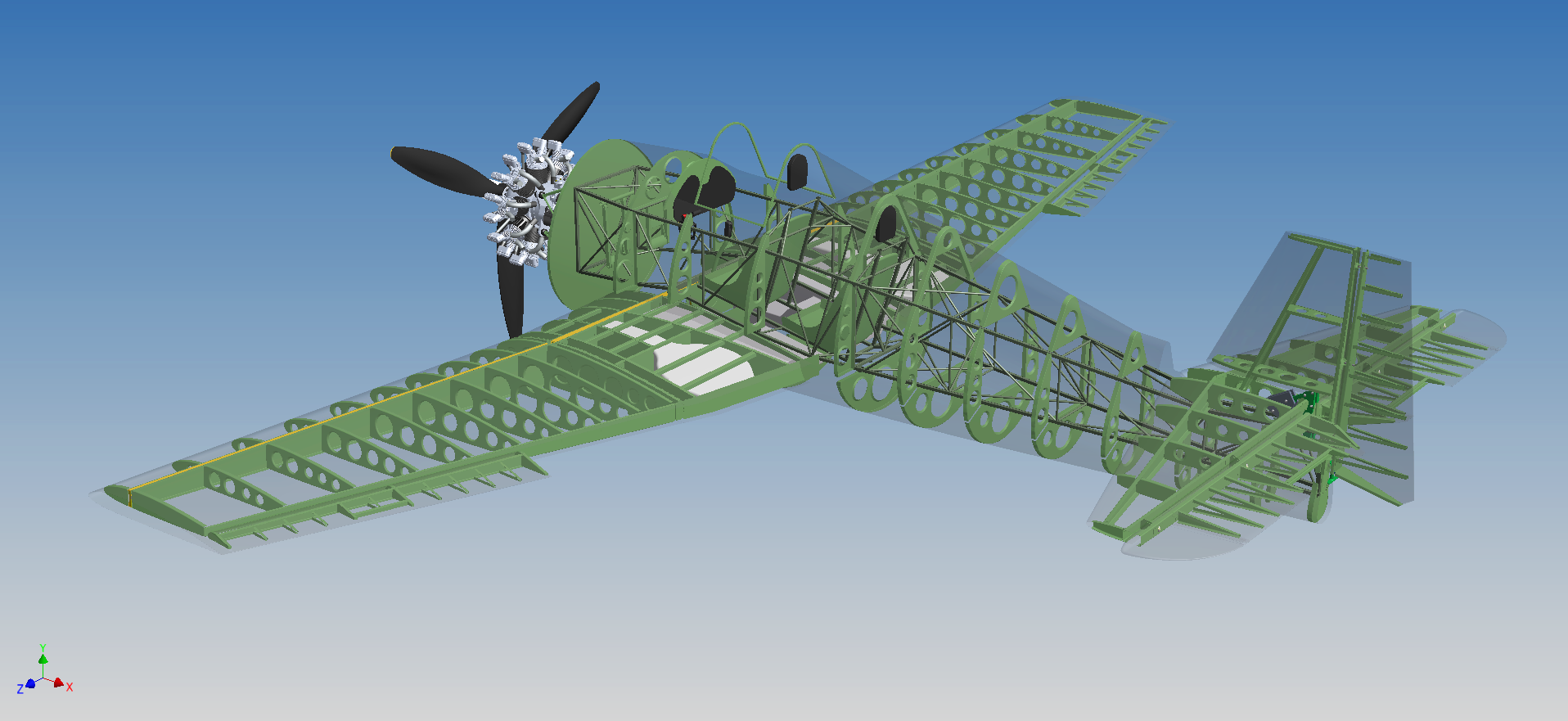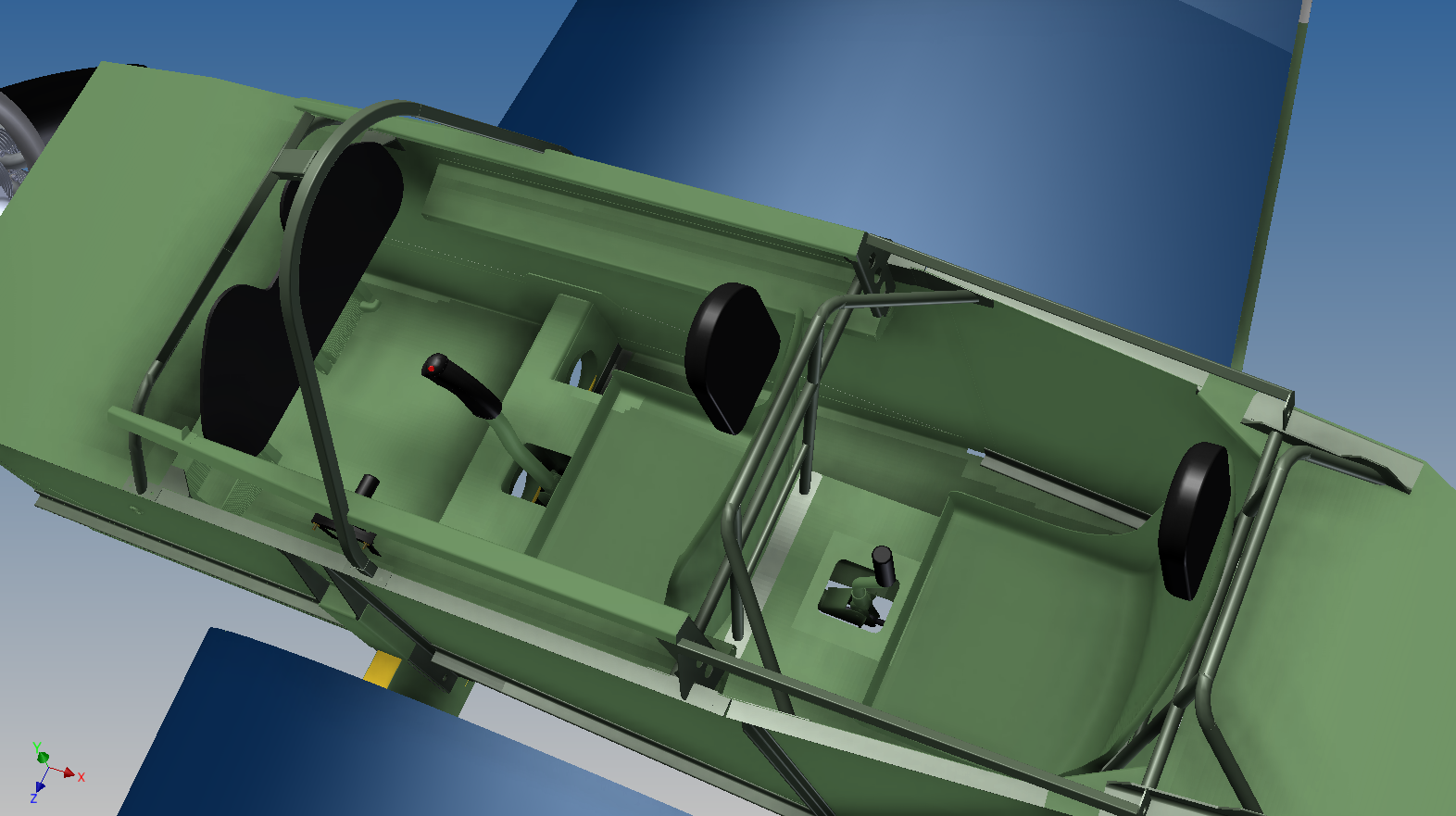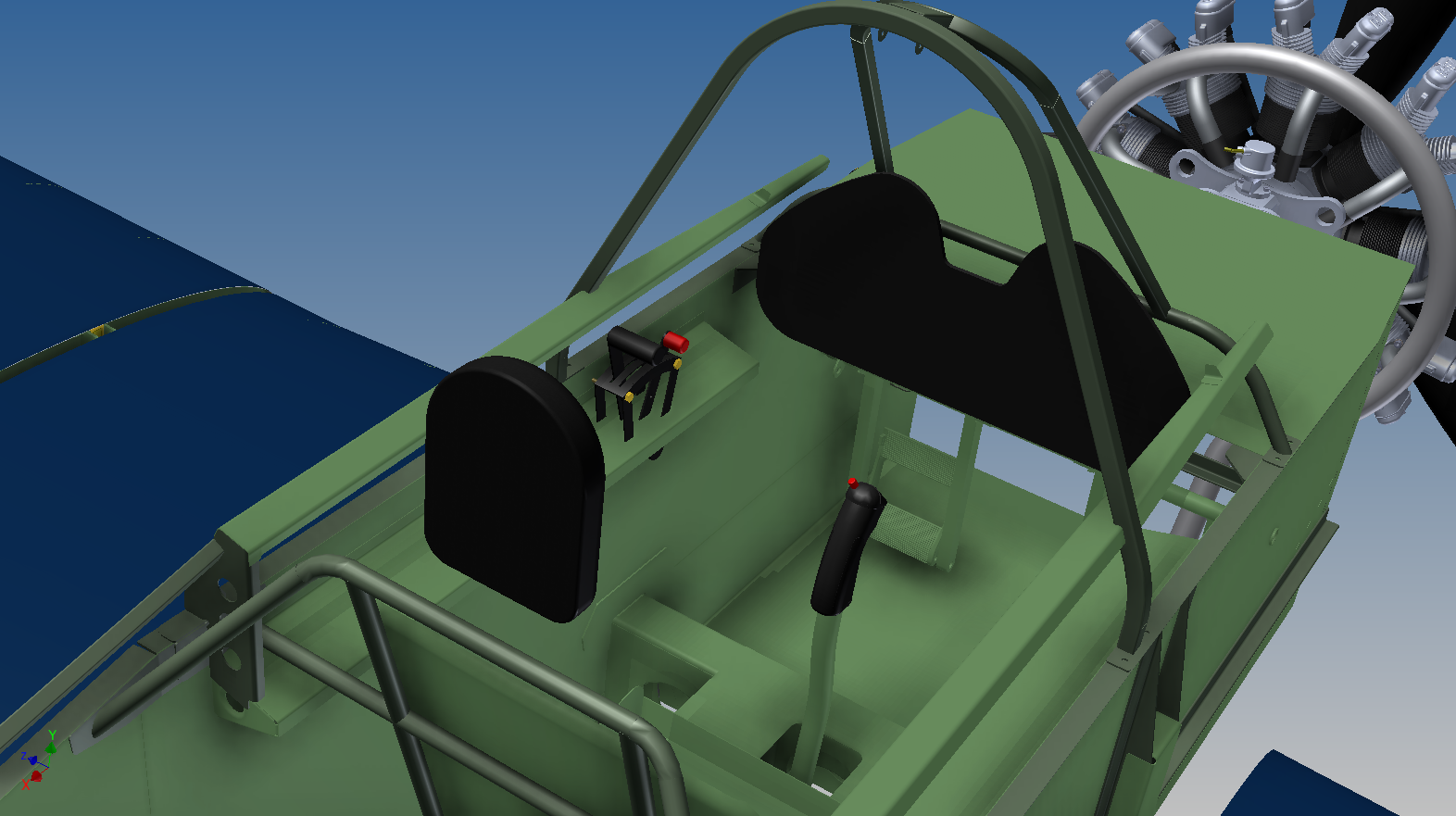DESIGN
History of the ScaleBirds Design
From talk to sketches, from mockups to static load samples, to building a CNC table to assist in fabrication; we've taken this idea a long way towards becoming reality, with many lessons learned along the way. The process began to take form in the fall of 2009. Now in 2015, we are beginning on the final flight article components of our first Hellcat prototype.
The project began by planning in 2D, sizing out the general concept on paper, before moving to a more detailed design of a few core designs, namely the Hellcat and Zero, using models and 3D design. It was decided early on that the Hellcat would be our flagship design: a bulldog of a plane with a sturdy radial engine and simple, bold lines, it was a prolific fighter of the war and has never been done as a replica kit.
With a target design, we moved to aerodynamic analysis and adjusted details to make our design a viable aircraft shape. With the shape set, it was a mater of how to make it physical. That has been the biggest hurdle yet, determining how the aircraft would be built, what methods would be used to construct our frames and skins and wings, how to assemble the various parts and sections, and debated over just how 'modular' the design needs to be. What parts should be common, which should be unique? What would work for the Hellcat but not the others? What elements define the essence of the aircraft?
Where it seems we have settled, is the result of many iterations on the core idea. But that core idea has survived intact: a core framework upon which a variety of warbird dreams can become reality. We'll go over the main concepts of the ScaleBirds design below.
The Airframe Design
The core of the ScaleBirds design is the 'inside-out' box airframe. Built in methods consistent with other light aircraft, the frame is a simple box made of CNC-cut aluminum sheets, and L-angles for the longerons and stiffeners. This box is 'inside-out' as, unlike most aircraft, the majority of the stiffeners and other features are on the outside of the box.
This method allows the design to be easy to build at home: it is trivial to square up a box-like structure on a table-top vs building a hollow conical tube shape typical of a semi-monocoque structure.
It also makes the cockpit area clean, almost all structural members are behind clean sheets of metal where they cannot cause injury or discomfort.
The other benefit is that it simplifies design for consecutive models. Almost all components and systems attach to the airframe, not the skin. Which means the airskin shape can change dramatically with minimal impact to the design of the other components.
Airskins: Designing the look of the Hellcat
A major design detail from the beginning is the outer surface of the fuselage being made of discrete panels we call "Airskins". This was originally implemented such that all Airskin panels would be removable panels, but the decision has been made to more closely integrate the airskins into the structure of the aircraft to increase strength-to-weight and because many areas will not need to be rapidly removed once the aircraft is complete.
The main benefit remains; that the entire structure of the aircraft can be built, cables run, systems installed, with the outer skin panels being the last thing to go on. This is the type of situation typically encountered on a fabric covered aircraft. This should enable the build process to go along fairly quickly. We're still planning to have the entire bottom skin of the aircraft made of easily removable panels, such that access to all cables and push tubes and hoses will be available during inspections.
In designing the skins of the Hellcat we used original 3-view drawings and lofts for inspiration, but ultimately created our own lofting based on requirements of this aircraft and the airframe. In scaling the larger fighter, some artistic license has to be used to capture the feel and lines of the original bird when strict scale is not possible due to aerodynamics and humans getting in the way. The lofting was done originally in 2D, but then re-defined in 3D Inventor using geometric constraints and layout to keep the shapes consistent as possible. This keeps the design tidy and simple, each loft is made of lines and arcs, and it was easy to tweak dimensions down the road and watch the entire skin adapt.
Some elements are still in development: The exhaust features are about halfway done. Detailed skin laps, doors and access panels, have yet to be introduced into the CAD. Many of these are going to be developed soon, while some of the more detailed elements are going to likely be handled on the physical prototype first, and then back-engineered into the official design as they are figured out.
Wings
The ScaleBirds aircraft will use a 3-section wing, with a carry-through spar in a center section that extends out to each landing gear. The Center Section mounts up to the Airframe from below as a completed unit.
Construction will be a conventional aluminum cantilever wing, with a built-up laminate spar, made of 2024-T6.
Airfoils will be a NACA 2415 base to a 2409 at the tip. It has 5' polyhedral as per the original.
Being a Hellcat, it will have a folding wing, though simpler than the original Hellcat, the resulting folded profile is meant to closely resemble the true Hellcat's stowed condition. The hinging mechanism is not load bearing in flight and only carries the unloaded weight of the wing when disconnected from the spar.
Armament details will include: Detailed faux machine gun barrels, ordinance rack mount points, and a 'gun compartment' in the outboard wing with gun/ammo doors. This can be used for faux machine guns or auxiliary luggage.
Wingtips will be composite, with provisions for full nav lighting.
Ailerons and outer flaps will be fabric covered, potentially using Oratex 6000. They will use push-tubes from the stick and electrically controlled trim tabs.
Flaps will be linked to a common push rod and electrically driven for ease of use.
Canopy
The Pilot's canopy will roll rearwards, mounted on tracks just like the original. A crank handle assembly for the canopy is planned but not finalized.
The ScaleBirds Hellcat being a sport plane, will have a second seat for carrying a passenger. Other replica warbirds do the same thing, but those without bubble canopies tend to require the pilot's seat to be folded or removed for access to the rear. This seems inconvenient in a major way. To keep the scale look but also enable easy access to the passenger seat, the rear passenger's canopy will hinge open to the right side of the aircraft when the pilot's canopy is fully retracted. With this open, the entire cockpit area is wide open for both pilot and passenger to climb in as needed.
For emergencies, quick pull pins will allow full canopy jettison. This will also be accessible to the passenger so they are not trapped in the back.
Powerplant and Firewall Forward
The choice of engine is both obvious, and yet very difficult. The entire scale of a replica aircraft is determined by the powerplant choice. This is true with a conventional aircraft design but even moreso with a replica, and especially more-so if the replica uses a radial engine. The challenge being that the available powerplants go from the approx 30" diameter Rotec series up to the approx 40" diameter radials of more classic origin.
Many have asked if the M14P engine and its kind would not be a better choice for our aircraft. The answer is yes and no. It would be a great engine for a Hellcat replica, but not this Hellcat. Anyone with the basics of aircraft design concepts under their headset would understand the problem; but at the core, it comes down to sizing, balance, and power. A larger radial grows the Hellcat very quickly, and the weight and cost would grow exponentially. In our case, our final goal is to make a viable replica kit platform, and for many sport pilots, the 400hp warbird replica is a lot of airplane to deal with. If not in performance, the costs involved approach that of owning a Texan or other original warbirds. That point is where the appeal of only having a replica becomes muddled.
But in the common sport plane power range of 1-200 HP, which is a reasonable aircraft to own and fly for many pilots, there is a clear choice.
So for ScaleBirds, the first and final answer has remained the same: the current Hellcat is designed to run on a Rotec R3600 9-cylinder radial, which delivers 150hp at full power.
Exhaust will be channeled through a custom exhaust assembly with 4 exhaust points in the original locations on the fuselage. The intent being that this will bring a varied, robust exhaust note to the aircraft, as well as produce authentic exhaust fouling along the fuselage. This step is not strictly required, the Rotec's stock exhaust ring would be workable in the Hellcat if required.
The cowling will have a composite nose bowl complete with the signature lower inlets, with aluminum side panels attached with quarter-turn fasteners to a sub-structure. For cooling our Hellcat will have ground-adjustable cowl flaps, and cylinder baffles.
Propeller choice is somewhat difficult. Many Rotec users are spinning fixed-pitch props, and this is fine for the WWI replicas and sportier aircraft. But for the Hellcat the only good answer is a classic-style 3-blade propeller with the proper spinner. That is somewhat available for a propeller of our size and power rating, but not commonly in an electrically driven constant speed. That is, the one downside of the Rotec is in a lack of provision for a hydraulic constant speed hub: it must be electrically driven. Luckily, there are some options and we'll be updating with more information as things develop.
Lastly, there have been maybe a few experiments out there with turbocharging the Rotec. This might be investigated at some point but its too early to really say.
Landing Gear
Landing Gear will for this version be fully retracting, though of course a fixed version is possible.
Main gear that rotate aft, while also pivoting 90' to bring the wheels flush to the bottom of the wing, as per the original. The original Hellcat used a bevel gear setup to achieve this, and the current design calls for a similar layout. However, a lighter-weight system may use a Corsair-style toggle link.
The main gear will attach to the front face of the center section spar as a module.
Tailwheel will retract as well. Currently this system is designed for hydraulic retract, though some thoughts have been given to an electrical actuator on the tailwheel. Instead of using a leaf spring, a full air shock style suspension system is being considered.
Why Modular?
The genesis of ScaleBirds started with the idea of wanting a kitplane that had enough power to rival other 2-seat sport planes, but had the looks of our favorite fighters. And this had been done so the idea wasn't too outside of the box. But of the people on the team, we had a lot of different favorites! Well, for some there's replica Mustangs to be found, not a problem; but what about the countless other fighters from WWII?
We realized that many of these warplanes, though unique each in their own way, tended to share a common proportion. The sizing and location of the wing in relation to the pilot and the engine and the tail surfaces, always seemed to fit into a tight envelope when you could freely scale the designs and put them on top of each other. This is what lead us to think of our design process not as a single aircraft, but the basis of a family. Thus, our 63% Hellcat may one day lead to a 70% Tomahawk, or a 75% YAK-3, or one of many many others.
There's no guarantee that we can do everyone's favorite warbird. And there's no guarantee we will ever move beyond the Hellcat. But the potential to grow the family in the future seems to make a lot of sense; the small compromises to use a core framework over making a design that can only ever be one plane, and which must be completely redone for the next replica, seem to justify their costs.








